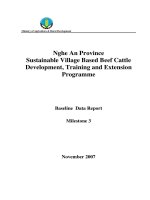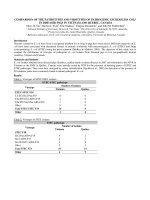Nghiên cứu khoa học nông nghiệp " A blueprint for sustainable smallholder pig production in Central Vietnam - MILESTONE 4 " docx
Bạn đang xem bản rút gọn của tài liệu. Xem và tải ngay bản đầy đủ của tài liệu tại đây (41.38 KB, 4 trang )
Ministry of Agriculture & Rural Development
Project Progress Report
A blueprint for sustainable smallholder pig production
in Central Vietnam
CARD Project 004/05VIE
MILESTONE 4 BASELINE SURVEY
1. Institute Information
Project Name
A blueprint for sustainable small holder pig production in
Central Vietnam
Vietnamese Institution
N
ational Institute of Animal Husbandry (NIAH); Hue
University of Agriculture and Forestry (HUAF); National
Institute of Veterinary Research (NIVR)
Vietnamese Project Team Leaders
Dr Ta Thi Bich Duyen (NIAH); Professor Nguyen Quang
Linh (HUAF); Dr Cu Huu Phu (NIVR)
Australian Organisation
The University of Queensland/Victorian Department of
Primary Industry/South Australian Research and
Development Institute
Australian Personnel
Dr Darren Trott, Dr Ian Wilkie, Dr Colin Cargill, Dr Tony
Fahy
Date commenced
April 1st 2006
Completion date (original)
April 2009
Completion date (revised)
September 2009
Reporting period
Milestone 4
Organisation
NIVR
Email:
2. MS achievements
a) Baseline survey and analysis of 80 randomly selected smallholder (10 -15 sows) and 20 larger
farms in 4 provinces including data on production levels, nutrition regimes, health and hygiene
status, welfare, housing and management regimes, environmental impacts, division of labour
and income and profitability.
b) Identification of suitable high priority project interventions and selected smallholders for
training and demonstration units and estimation of potential physical and financial impacts.
Evidence:
a) Baseline survey:
The University of Queensland developed, substantially tested and re-launched an on-line database
for accurate recording of paper based surveys, including an image upload capability. The role of the
database is not to gather exhaustive data from every farm surveyed in Vietnam but be able to
quickly recognise systems that work, major constraints to production and what types of
improvements need to be made. Therefore data collected from each of farms selected for
demonstration units will be more extensive and each time they are visited a photographic record
will supplement analysis of data.
We have now extensively tested the system within Vietnam and it has undergone several versions.
The most up to date electronic version is available at:
To view data enter username “AUSAIDCARD” password “pigproject”. Then click the “Edit
existing forms button” then click the “Display all possible forms” button to choose an individual
farm to view the data. Click on “submit your data now” at the end of the individual farm data to
return to the start screen. (Note: you will receive the following message: Sorry. As user
AUSAIDCARD you don't have rights to edit records).
Data has been initially submitted for a total of 40 farms from Binh Dinh province (NIVR
responsibility), 44 farms in Quang Tri (NIAH responsibility), 87 farms in Quang Nam and 98 farms
in Thua Thien Hue (HUAF responsibility).
We identified a number of problems with the implementation of the survey. This became apparent
when we were fortunate to have a veterinary science undergraduate student volunteer to spend
several months in Vietnam (1
st
December 2007-26
th
January 2008) working on our project. The
student diligently went over the translated paper survey forms from each institute and rigorously
tested the on-line system from a Vietnamese internet connection in the field. Firstly, several
important survey points were lost in the translation from English to Vietnamese. Secondly, several
differences arose in the written surveys used by each institute. Thirdly, some small glitches in the
programming were identified that were not previously picked up when the system was tested in
Australia. Fourthly, in conducting surveys on the farms selected for upgrade, training and
continuous improvement, it was found that several questions needed to be changed in order to
obtain the right information or enhance the quality of information gained. Finally, the internet
connection in Vietnam was often very slow making it difficult to sometimes fill out surveys online
and upload pictures and plans. More specific details can be found in Ms Tarni Cooper’s trip report
(see Appendix One: Ms Tarni Cooper Trip report). The student has collated a lot of information and
has spent the last few months working with the UQ web survey designer, Warren Ham, to develop a
shortened version of the electronic questionnaire (reported in MS 3-this shortened version was
designed with Mr Phuong from HUAF) and to fix all of the problems identified. She has also been
employed (on another project grant) to devote 10 hours per week to continue to develop the
database and a website devoted to the project and keep in contact with the Vietnamese scientists, in
particular Mr Bien from NIAH and Mr Phuong from HUAF to keep refining the quality of data
collected. Her contribution to the project has been so productive that we plan for her to spend
another two months in Vietnam at the end of the year to continue the good work. It is often difficult
for Australian scientists to spend longer than several weeks in Vietnam, therefore fine attention to
detail such as the accuracy and consistency of electronic survey records between institutes is often
not possible. Student placement promotes friendship, collaboration and excellent training for a
future veterinarian who wishes to work in developing communities.
b) Analysis
HUAF have analysed the results of their survey (a total of 220 farms in Thua Thien Hue and Quang
Nam) using SPSS which are summarised as follows: (see Appendix Two: Report of Survey
Activities in Quang Nam and Thua Thien Hue). Sow numbers ranged from 1 to 20 with a mean
number of sows of 3.5 and 84% using the Mong Cai local breed. A total of 93% of farms kept less
than 11 sows (ie 1-10) and 89% had less than 6 sows (ie 1-5). Key demographic data included the
fact that 98.4%, 80%, 35% and 7% of farmers had completed primary, high primary, secondary and
post-secondary education, respectively, but education level did not influence sow numbers.
Interestingly all farmers had more than 5 years pig husbandry experience and 89% more than 10
years. Mean number of pigs born live was 12.04 ± 1.63 with Mong Cai averaging 12.61 and exotic
breeds only 9.95. Stillbirths (which includes early birth mortality from being squashed by the sow)
averaged 15.9% overall (13.7% for Mong Cai and 32.8% for exotics). Mong Cai are very good
mothers and rarely require farrowing crates. Over 80% of litters were reported to have diarrhoea,
with 12.2% having greater than 55% of piglets in the litter affected. Factors that may predispose to
diarrhoea included poor housing and lack of temperature control, lack of E. coli vaccination, poor
management systems and hygiene, including the common practice of hosing out creep areas daily.
Key constraints to production included nutrition and general feeding levels (restricted vs ad lib
feeding of sows), housing and ventilation, lack of boar stimulation causing delayed and inconsistent
oestrus patterns and returns to service and lack of on-farm recording data meaning that it was
impossible to determine the number of pigs/sow/year produced. The main outcomes of the survey
are also summarised in a powerpoint presentation given by Dr Colin Cargill in October 2007 during
a CARD visit to The University of Queensland (see Appendix Three: CARD REPORT). Survey
data in Excel format is available on request and individual farm records for the majority of farms
have been entered into the online database.
NIAH and NIVR have entered their farm data into Excel from Quangtri and Binh Dinh, respectively
(available on request contact Dr Duyen NIAH; Dr Thuy NIVR) but has not analysed their data
completely as they have been waiting for the UQ on-line system to be perfected, a task that has only
been completely achieved in the last few weeks after extensive troubleshotting by Ms Tarni Cooper
and the UQ web designer. However based on numerous farm visits that have taken place in
Quangtri (trip reports by Colin Cargill submitted with MS3) it would appear that apart from
differences in local climate and the types of feedstuffs available, the farms have very similar
problems to those identified in Quang Nam and Thua Thien Hue. Analysis of the combined four
sets of data (Binh Dinh, Quang Tri, Quang Nam and Thua Thien Hue) will require further careful
translation, editing and cross checking by Ms Tarni Cooper (now we are 100% happy with the
online system) on her next trip to Vietnam to confirm accuracy and correct inconsistencies between
institutes. We intend to publish this data in a high ranking journal, thus we are committed to
ensuring accuracy and consistency. It may be advisable at this point in time to resurvey all the farms
again and compare data with the previous survey, now that the recording system has been perfected.
This was to be done at the conclusion of the project in September 2009, but the ongoing problems
with FMD and PRRS in Vietnam may require this to be brought forward to January 2009.
c) Identification of suitable high priority project interventions (See Appendix Four: High priority
project interventions).
d) Selection of smallholder demonstration units
Both NIAH and HAUF have ranked and chosen the top 25-30 farms for upgrade to become
demonstration units. Upgrade of facilities, introduction of new improved breeding stock and
adoption of best practice and continual improvement has proceeded on these selected farms over the
last year. Most farms are still a work in progress, but significant gains have been made. The selected
farms can be viewed in the database at anytime as they are completed and are identified by farm
code number and the interviewer’s name (ie Tarni). Each record will also have a farm plan showing
renovations and improvements, photos of the owner and their family and photos of the premises and
stock showing improvements that have been made during the life of the project. Entries have now
been made into the audit database for latitude and longitude measurements to be recorded by GPS.
This will be undertaken during the May training programme.
e) Threats to Project.
PRRS (blue ear disease) has recently been detected in Thua Thien Hue province and to date has
impacted on three farms that are within our survey group (Appendix Five: Pictures of pig slaughters
from TTH). An epidemic of disease and the resultant eradication or management campaign is
something that our project cannot possibly insulate against at this point in time. Given that farmers
are compensated for their losses, we can confidently say that our training and continuous
improvement of stock, facilities, management and husbandry will allow farmers to rapidly start up
production again.









